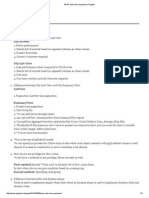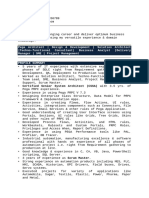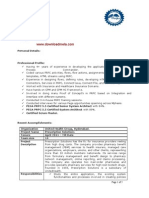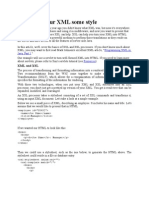Activities:: Work-.Addwork Work-.Add
Activities:: Work-.Addwork Work-.Add
Uploaded by
jithendra babuCopyright:
Available Formats
Activities:: Work-.Addwork Work-.Add
Activities:: Work-.Addwork Work-.Add
Uploaded by
jithendra babuOriginal Description:
Original Title
Copyright
Available Formats
Share this document
Did you find this document useful?
Is this content inappropriate?
Copyright:
Available Formats
Activities:: Work-.Addwork Work-.Add
Activities:: Work-.Addwork Work-.Add
Uploaded by
jithendra babuCopyright:
Available Formats
Activities:
1. What are the Pega Activities we used?
Work-.Add Creates a new work object (without any cover work object) and performs a Commit
method, which saves the work object and releases all locks.
Work-.AddWork Use Work-.AddWork rather than Work-.Add in situations where the Commit
method is not wanted until later.
AddCoveredWork Creates a new cover work object but does not perform a Commit method, so
current locks are retained.
Work-.AddCovered Use Work-.AddCovered rather than Work-.AddCoveredWork to commit the
new work object.
AddWork Creates a new covered or non-covered work object. Called with a primary page that
inherits from the Work- base class. Commits the new work object if there is no flow execution to
start; if it starts a flow execution, the commit operation typically occurs when that flow execution
creates an assignment.
New Called by harness processing to create a (non-covered) work object and display the work object
form.
NewCovered Called by harness processing to create a covered work object and display the work
object form.
Assign-Worklist Creates a normal assignment (Assign-Worklist class) added to a user's worklist.
Assign-Workbasket Creates a normal assignment (Assign-Workbasket class) added to a
workbasket. If the workbasket doesn't exist, the assignment can be routed to the current user.
Notify Send an e-mail message as correspondence to a party identified through a parameter.
NotifyAll Send a single e-mail message to each work party identified in the work object.
ToCreateOperator Route the assignment to the user who entered the work object.
ToWorkbasket Routes the assignment to a workbasket identified in a parameter.
ToWorklist Routes the assignment to the worklist of a specific user, identified in a parameter.
CorrNew Send correspondence (that requires no user interaction), and save it as an attachment to the
work object. For email output, can send all work object attachments or selected work object
attachments as email attachments. The optional Priority parameter allows the outgoing mail to be
marked as high or low priority in certain e-mail client programs, such as Microsoft Outlook.
Assign-.NewDefaults Called from Work-.NewAssign and Work-.NewAssignBasket on the
assignment. Allows the developer to customize or extend the steps that are performed when a new
assignment is created.
Work-.NewDefaults Called from Work-.New and Work-.NewCovered. Override to customize or
extend the steps that are performed while creating new work page for the New harness.
2. What's the difference between parameters and local variables? How are they used in an
activity?
Values stored in parameter values can be shared between two activities but the scope of local
variables is confined to the activity in which they are declared.
Parameters can be referenced as Param.parametername.
Local variables are referenced as Local.variablename.
3. How can we pass parameters between activities? Explain.
By using In/Out parameters. In parameters means that its expecting a values from another activity
and Out parameter stores the values to be used by another activity.
4. Explain with an example how can we reuse an activity?
By parameters itself. Say for example we have an activity to append two strings which keeps
changing as the application proceeds.
So declare two parameters of type Strings and pass different values to it, but the business logic to
append them will always remain the same, only parameter values keeps on changing.
5. What is a step page what role does it play in an activity?
Each step in an activity may have a designated step page. When creating or updating an activity, the
developer identifies an existing or new clipboard page for the method (or instruction) in that step to
act on, in a column of the tab labeled Step Page.
The step page becomes the primary page for the duration of this step's execution.
So any rule referenced in this step will be looked upon in the class associated with that step page, if
there is no step page than the Applies To class will considered.
6. How to write a java code in a activity? Explain with a small example.
Just by using an API “java” in method tab.
Eg. If we want to access a clipboard property then the java code will be like,
Tools.findPage(“pageName”).getString(“.PropertyName”);
7. Consider this scenario, I have an activity in ruleset A and I want to call this activity from an
acitivity in ruleset B.Is this possible? If yes, how?
Yes, this is possible through ruleset prerequisites.It is defined under Rule-Ruleset-Version.
Note : Process Commander enforces RuleSet version prerequisites only during development (as a
developer adds or saves rules) and as rules are imported during Import Archive operations.
Prerequisites are not enforced at runtime; the user's RuleSet list and the rule resolution algorithm
determine which rules are available for the user to execute.
8. What is show-page and show-html? Explain with example.
Show-Page is used to display any clipboard page in XML form (name-value pair).
Show-HTML method is used to cause the activity to process an HTML rule and send the resulting
HTML to a user for display by Internet Explorer. Also known as stream processing. This may
involve the interpretation of JSP tags (or the older HTML directives), which can access the clipboard
to obtain property values, or can insert other HTML rules, and so on.
9. Explain about Onchange Activity?
OnChange activity to be executed automatically by a Declare OnChange rule, Such activities must
not use any methods that directly change the properties or the database.
Declare Expression rules do not evaluate during the execution of an OnChange.activity. OnChange
activities must not perform any forward chaining themselves.
10. Explain about Trigger Activity?
Trigger activity to be executed automatically by a Declare Trigger rule. Because triggered activities
run during database commits, they cannot themselves commit database transactions.
11. How do we create a Work Object from Activity?
First Create NewPage with a Page-New
Within the Page-New step specify the “model” and “NewClass”
On the new page Set the properties
.pyFlowName with FlowName
.pyDescription
.pyOrigOrg
.pyLabel
Call Add activity in the next step and specify the StepPage where we have to call the
WorkObject
Call Add Creates the WorkObject where the activity belongs to type of the class.
You might also like
- Access Deny & Privilege in PegaDocument23 pagesAccess Deny & Privilege in PegaNisha Agarwal 3No ratings yet
- Validations in PegaDocument1 pageValidations in PegaManikantaPatchipulusNo ratings yet
- Red Hat OpenShift The Ultimate Step-By-Step GuideFrom EverandRed Hat OpenShift The Ultimate Step-By-Step GuideRating: 1 out of 5 stars1/5 (1)
- JPFDocument5 pagesJPFJose ToledanoNo ratings yet
- HTML 5 Black Book Covers Css 3 Javascript XML PDF HTML 5 Black Book Covers PDFDocument2 pagesHTML 5 Black Book Covers Css 3 Javascript XML PDF HTML 5 Black Book Covers PDFBreeze Jaspreet100% (1)
- Pega Test Topics - ActivitiesDocument6 pagesPega Test Topics - ActivitiesWilsmith SmithNo ratings yet
- Java and ActivitiesDocument58 pagesJava and ActivitiesKamesh AnandNo ratings yet
- PEGA Interview Questions and AnswersDocument59 pagesPEGA Interview Questions and AnswersMahesh WaghNo ratings yet
- Question Bank-PRPCDocument22 pagesQuestion Bank-PRPCsinu541No ratings yet
- PEGA Course ContentDocument8 pagesPEGA Course ContentFree LancerNo ratings yet
- Pega Integration With ChatgptDocument13 pagesPega Integration With Chatgptarka prava LahiriNo ratings yet
- Health Insurance ProjectDocument8 pagesHealth Insurance ProjectMahesh WaghNo ratings yet
- AgentsDocument43 pagesAgentsPrashanthNo ratings yet
- Pega Web MashupDocument4 pagesPega Web MashupVishnupriya SivakumarNo ratings yet
- SLA in PEGA How To Configue Service Level Agreement - HKRDocument7 pagesSLA in PEGA How To Configue Service Level Agreement - HKRsridhar varmaNo ratings yet
- Data TypesDocument4 pagesData TypesmahendraNo ratings yet
- Scrum Sizing Guide For V22 - 2 - v2Document12 pagesScrum Sizing Guide For V22 - 2 - v2BharadwajaChennupatiNo ratings yet
- Pega Study Tutorial Interview QuestionsDocument318 pagesPega Study Tutorial Interview QuestionssubbaraogaddamNo ratings yet
- Pega 7 Online Training @whats App: +91-9908107432Document4 pagesPega 7 Online Training @whats App: +91-9908107432ashockNo ratings yet
- Pega FaqsDocument3 pagesPega FaqschakramscribdNo ratings yet
- PEGA Services and ConnectorsDocument16 pagesPEGA Services and ConnectorskasimNo ratings yet
- Cssa Q&aDocument43 pagesCssa Q&aGaddam NeerajNo ratings yet
- Declarative RulesDocument2 pagesDeclarative RulesSvr RaviNo ratings yet
- Joins Associations and SubreportsDocument4 pagesJoins Associations and SubreportsPunam TaurNo ratings yet
- Creating The Booking and FSG ApplicationsDocument5 pagesCreating The Booking and FSG ApplicationskrishnamurthyyadavNo ratings yet
- PRPC IntroDocument14 pagesPRPC IntroDee Ps67% (3)
- Dumps CssaDocument14 pagesDumps CssapunithaNo ratings yet
- Pega Day 1Document31 pagesPega Day 1Mohanavel KathirvelNo ratings yet
- Myknowpega Com 2019 11 15 Tickets-In-PegaDocument22 pagesMyknowpega Com 2019 11 15 Tickets-In-PegaPavan KumarNo ratings yet
- Pega ContentttDocument10 pagesPega ContentttChandra MohanNo ratings yet
- Q3 AnswersPega Sample CSSA QuestionsDocument23 pagesQ3 AnswersPega Sample CSSA Questionsvaucis0% (1)
- Pega Certification Bullet PointsDocument61 pagesPega Certification Bullet PointsmdtaufeeqNo ratings yet
- Pega Training Plan: Day Week ObjectiveDocument2 pagesPega Training Plan: Day Week ObjectiveKrishna BabuNo ratings yet
- Health Insurance Project RequirementDocument6 pagesHealth Insurance Project Requirementsreekanth DevarakondaNo ratings yet
- PRPC Interview Questions - Pega4uDocument3 pagesPRPC Interview Questions - Pega4unarendra239_qisNo ratings yet
- Working With Tracer in Pega PRPCDocument16 pagesWorking With Tracer in Pega PRPCraviNo ratings yet
- PegaDocument1 pagePegasunilchopseyNo ratings yet
- 26dec-Pega PRPC ToolDocument15 pages26dec-Pega PRPC ToolKrishna ReddyNo ratings yet
- Reports & AgentsDocument49 pagesReports & AgentsSrikanthNo ratings yet
- SecurityDocument149 pagesSecurityHarish Babu YemineniNo ratings yet
- Pega OwnDocument102 pagesPega OwnNag ReddyNo ratings yet
- Peg A Interview QuestionsDocument1 pagePeg A Interview Questionshemantp81No ratings yet
- Pega Arch 1Document5 pagesPega Arch 1Cricket Live StreamingNo ratings yet
- Activities 15 % of EXAM: Material For PRPC CertificationDocument36 pagesActivities 15 % of EXAM: Material For PRPC CertificationashokbogavalliNo ratings yet
- Pega Interview QuestionsDocument376 pagesPega Interview QuestionsadityaNo ratings yet
- PEGA 7 CSA QuestionsDocument23 pagesPEGA 7 CSA QuestionsashokbogavalliNo ratings yet
- Working With Web ServicesDocument25 pagesWorking With Web Servicessatyanarayana chitikala appala venkataNo ratings yet
- 23.4 Exercise 8 - InterfacesDocument18 pages23.4 Exercise 8 - InterfaceslucasfuentesgalanNo ratings yet
- 13-Rfi-001-Lj Workforce Information Technology Procurement Project - A Florida Workforce Saas (Software As A Service)Document36 pages13-Rfi-001-Lj Workforce Information Technology Procurement Project - A Florida Workforce Saas (Software As A Service)Sanjay JagdaleNo ratings yet
- PRPC Bullet Pointsv02 PDF FreeDocument56 pagesPRPC Bullet Pointsv02 PDF FreeSanthosh LuckyNo ratings yet
- Enterprise Class Structure LayersDocument5 pagesEnterprise Class Structure LayersFrancisco Gumescindo LimonNo ratings yet
- Pega Interview QuestionsDocument3 pagesPega Interview Questionsshiva1533100% (1)
- CSSA Study Guide For Pega 7.1 - February 2016: How Branches WorkDocument60 pagesCSSA Study Guide For Pega 7.1 - February 2016: How Branches WorkDavid LewisNo ratings yet
- Which Statement About Managing Encrypted Data in Pega Platform Is TrueDocument6 pagesWhich Statement About Managing Encrypted Data in Pega Platform Is Truesai saiNo ratings yet
- Pega Rules Process 4 Years Experience Sample ResumeDocument5 pagesPega Rules Process 4 Years Experience Sample Resumesaratchandra1225No ratings yet
- PEGA Interview Set03Document8 pagesPEGA Interview Set03satyach123No ratings yet
- PEGADocument14 pagesPEGASuper SuryaNo ratings yet
- HTML Your VisualDocument139 pagesHTML Your Visualapi-3750135No ratings yet
- Microsoft Windows-7-Interview-Questions-and-Answers PDFDocument3 pagesMicrosoft Windows-7-Interview-Questions-and-Answers PDFram kumarNo ratings yet
- Enterprise Search Using Elastic SearchDocument36 pagesEnterprise Search Using Elastic SearchVaibhav NautiyalNo ratings yet
- Thinking in JavaScriptDocument31 pagesThinking in JavaScriptzolegf80% (5)
- Mooc 1Document21 pagesMooc 1namvipor0904No ratings yet
- React Interview Questions 2024Document286 pagesReact Interview Questions 2024vineet.tijare07No ratings yet
- XHTML Interview Questions (2021) - JavatpointDocument4 pagesXHTML Interview Questions (2021) - JavatpointChandan GowdaNo ratings yet
- Fundamentals of Internet Programming All in One HandoutDocument59 pagesFundamentals of Internet Programming All in One Handoutmaxwellkagali15No ratings yet
- HTML Tags Chart: Tag Name Code Example Browser ViewDocument9 pagesHTML Tags Chart: Tag Name Code Example Browser Viewkannadiparamba100% (12)
- Quiz #1: AnswerDocument25 pagesQuiz #1: AnswerDorson AdoraNo ratings yet
- Competency/Trend - Nxt/Pages/Bootstrap-L1.Aspx: Sensitivity: Internal & RestrictedDocument3 pagesCompetency/Trend - Nxt/Pages/Bootstrap-L1.Aspx: Sensitivity: Internal & RestrictedParshuram ReddyNo ratings yet
- Computer Networks & DiagramsDocument42 pagesComputer Networks & DiagramsYatharth SinghNo ratings yet
- HTML - TablesDocument50 pagesHTML - TablesWAAD IBRANo ratings yet
- XSL Gives Your XML Some StyleDocument13 pagesXSL Gives Your XML Some Styleapi-3875928No ratings yet
- School Management SystemDocument42 pagesSchool Management SystemFurqan KhanNo ratings yet
- Creating Amazing Visualisations With Sas® Stored Processes and Javascript LibrariesDocument20 pagesCreating Amazing Visualisations With Sas® Stored Processes and Javascript LibrariesManuelNo ratings yet
- Basic Web Page CreationDocument9 pagesBasic Web Page CreationElgin CasquejoNo ratings yet
- Computational Data Science (1) - 240728 - 180556Document30 pagesComputational Data Science (1) - 240728 - 180556riya.munjal.ug21No ratings yet
- Online Pharmacy Management SystemDocument19 pagesOnline Pharmacy Management SystemPraveena PNo ratings yet
- Smashing Book 4 New Perspectives On Web DesignDocument496 pagesSmashing Book 4 New Perspectives On Web DesignMirosław Ciastek100% (1)
- Web Design & Development: Week 02 by Shakeel AhmadDocument94 pagesWeb Design & Development: Week 02 by Shakeel AhmadShakeel AhmadNo ratings yet
- Sit774-9 1PDocument4 pagesSit774-9 1PTanzeel MirzaNo ratings yet
- EcommerceDocument25 pagesEcommercejacobjabsNo ratings yet
- Enhanced Web Site Design: Stanford University Continuing Studies CS 22Document56 pagesEnhanced Web Site Design: Stanford University Continuing Studies CS 22pushpanjaliNo ratings yet
- Elective - FYBSC Sem1 Computer PracticalsDocument2 pagesElective - FYBSC Sem1 Computer Practicals5paisaNo ratings yet
- WK6 LAS Programming-1Document16 pagesWK6 LAS Programming-1EdralynNo ratings yet
- Cs411-Visual Programming: Finalterm PapersDocument20 pagesCs411-Visual Programming: Finalterm PapersKamran Mahmood100% (1)
- Website: 1. How To Insert Table in WebsiteDocument12 pagesWebsite: 1. How To Insert Table in WebsiteOrangBiaseLakersNo ratings yet
- Web-Designing-Kit-401 2022-23Document2 pagesWeb-Designing-Kit-401 2022-23Siddharth singh RaghuwanshiNo ratings yet

























































































